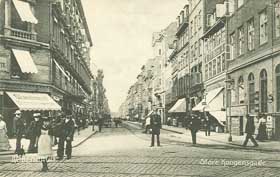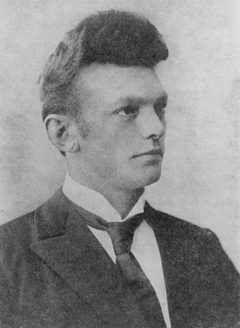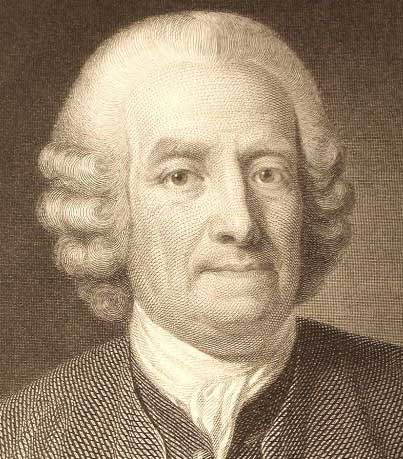In a 1905 séance with the Icelandic medium Indridi Indridasson (1883–1912), a communicator described a fire taking place in Copenhagen, giving details that were found to match those in subsequent newspaper reports. The case is similar to the reported clairvoyant vision by Swedenborg in the eighteenth century, of a fire raging in Stockholm.
Contents
Events
A new communicator appeared at a séance of Icelandic medium Indridi Indridason1See Haraldsson & Gissuarson (2012). briefly on 24 November 1905. He spoke Danish and introduced himself as ‘Mr Jensen’, a common Danish surname. No sitter recognized him. Later in the evening Jensen returned. He stated that he had been to Copenhagen (1,300 miles distant) and described a fire raging in a factory there.
Three witnesses described Jensen’s statements. Haraldur Nielsson, a theology professor, wrote:
The first evening he [Mr Jensen] manifested himself through the medium, he told us that in the half-hour pause while the medium was being allowed to rest in the middle of the sitting, he had set off for Copenhagen and had seen that a factory was on fire in one of the streets of the city. He told us that the firemen had succeeded in conquering the fire. At that time no telegraphic connection between Iceland and the outside world had been established, so there were no means of recognizing that event.
This happened on 24th November 1905. Next day I went to see the Bishop of Iceland, the Right Reverend Hallgrimur Sveinsson, who was my uncle, and stated to him what Jensen had told us, and asked him to write it down and be a witness, whether it proved true or not.
At Christmas the next boat came from Denmark, and my uncle looked with curiosity through the Danish paper, Politiken, and to his great content, observed the description of the fire. Both day and time were right. About the factory Jensen was also right. It was a lamp factory in 63 Store Kongensgade [a major street in Copenhagen].2Nielsson (1922), 456.
Einar H Kvaran gave a more detailed account in a lecture given in Copenhagen and spoke about when Jensen appeared for the first time:
This your fellow countryman whom we have come to like so much, presented himself for the first time as he appeared through the medium in a very distinct and elegant manner. He [Jensen] told us that he had come directly from Copenhagen, and that there was a fire there: a factory was burning. The time was about 9 o’clock when he came. Then he disappeared and came back an hour later. Then they [the firemen] had conquered the fire, he said. We did not have any telegraph at that time, so we had to wait to have this statement verified. But we wrote down his account and kept the document with the Bishop [who had taken part in earlier séances]. With the next ship [from Copenhagen], the papers brought us the news that there had been a large fire in Copenhagen that evening—in Store Kongensgade, I think it was—where amongst other things a factory had burnt. It also said that at about 12 o’clock the fire had been brought under control. As you know, the time is about 12 o’clock here in Copenhagen when it is 10 o’clock in Reykjavik.3Kvaran (1910), 46.
There are discrepancies with regard to timings between the accounts of Nielson and Kvaran, but the essential facts are the same, and were further corroborated by Kvaran’s wife.4Thordarson (1942), 102. As well as stating the fact of a fire that evening in Copenhagen, Jensen added specifics:
- The fire was in a factory.
- The fire started around midnight on 24 November 1905.
- The fire was brought under control within an hour.
On the day following the séance, Saturday the 25th of November, two major Danish newspapers reported a fire in Copenhagen. Politiken writes:
Factory Fire in St. Kongensgade. Copenhagen’s Lamp and Chandelier Factory in Flames
Last night at about 12 o’clock the janitor of number 63 Store Kongensgade [Kongensgade Street] discovered that there was a fire in “Copenhagen’s Lamp and Chandelier Factory,” which is located on the ground and first floor of a side house in the back yard.
He called the Fire Brigade and soon fire-extinguishing carriages from Adelsgade Fire Station and the main Fire Station arrived under the direction of Fire Chief Bentzen. The first floor was already ablaze with powerful flames reaching out of the windows and breaking the glass in the windows on the second floor where there is a factory for making cardboard boxes.
The Fire Brigade quickly attached two hoses to fire hydrants. One of the hoses had to go across the street so all tram traffic came to a halt. The water from the two hoses soon subdued the fire but then it was discovered that the fire had gone through the ceilings to the floors above the factory. [There follows a detailed description of the work of the fire brigade].
In about half an hour the fire had been diminished to such an extent that the firemen could remove the hoses across the street to let about a dozen trams pass that had been waiting, after which the hoses were connected again. … It became obvious that the fire had caused quite a substantial damage. Walls and floors had been burnt out and both stocks and machines of considerable value had been destroyed. There was still fire in some places. … Around 1 a.m. some of the firemen and equipment were able to leave but a fairly large number of firemen had to remain at the location for a further hour and a half. The fire is assumed to have started by a breakdown in an electric circuit.
In researching this claim in Copenhagen city archives, Erlendur Haraldsson found the fire brigade’s report of the fire at 63 Store Kongensgade on 25 November 1905. This report states that the fire was violent. In the house there were three workshops with much flammable material. The fire had been fully extinguished at 2 am. The cause of fire was unknown.
Nielsson gives no exact time for Jensen’s statements about the fire, only that they occurred during a pause for the medium to rest, which would presumably have been late in the séance which took place on Friday evening. The sittings started at 8 pm and lasted up to a few hours. Kvaran writes that it was around nine when Jensen told them about the fire, and then an hour later that the fire had been brought under control. The time in Copenhagen would then have been 11.15 pm, as the time difference between Reykjavik and Copenhagen was two hours and fifteen minutes at this time.
According to the Fire Brigade, it was called at 11.52 pm (9.37 pm Icelandic time). The fire may have been burning for a while before it was noticed, and then it would have taken a few minutes for someone to run to the nearest fire alarm. Kvaran’s statement about the time when Jensen spoke of the fire must be an estimate; the records indicate that it is likely to have started sometime after 9 pm. There is a reasonably close correspondence.
The fire was brought under control in half an hour, according to Politiken. Kvaran’s timing here comes quite close: he writes that Jensen came back after one hour and claimed that the fire was under control.
Analysis
How frequent were newsworthy fires in Copenhagen at the beginning of the twentieth century? Could it be a fluke of chance that this fire coincided with Jensen’s statements?
Haraldssson checked the frequency of fires reported in Politiken. In a four-week sampling period from two weeks before the fire in Store Kongensgade to two weeks afterwards, four fires were reported in the newspaper, including the fire in Store Kongensgade. Only one fire took place in the evening, and only one fire took place in a factory, namely the Store Kongensgade fire; it was the largest fire, and caused most damage.
Jensen got it right that a fire took place in Copenhagen in the evening of 24 November 1905, that it was in a factory. and that it was brought under control in about an hour. Telephones did not come to Reykjavik until almost a year later, and telegraphy not until 1918. It is difficult to identify a normal explanation for the fact that Jensen – or for that matter the medium Indridi Indridasson – was able to describe in detail and in real time an emergency taking place some thirteen hundred miles away.
Search for Jensen’s Identity
Who was Jensen? Was he just a figment in the mind of Indridi, or had he been a real living person?
The only information given in the account of Nielsson is that Jensen was a manufacturer (fabrikant).5Nielsson (1922). Kvaran6Kvaran (1910). describes him as a clothing manufacturer (klædefabrikant) and a native of Copenhagen which, he writes, could easily be determined from his ‘genuine Copenhagen accent’. That is all we know from those who wrote about Indridi and his phenomena. Kvaran wrote of Jensen: ‘never did we come to know anything about who he was when he was living’.7Kvaran (1934). Following this first appearance on 24 November, Jensen made frequent appearances, often in relation with light phenomena and attempts to produce materializations. However, not a word is found about his identity.
Two volumes of minutes of séances recorded by the sitters came to light in the 1990s. One starts with a sitting on 4 December 1905, ten days after the sitting in which the fire in Copenhagen was described. Jensen appears again at a sitting on 11 December 1905. Here, apparently in response to a request for information, he makes several specific statements about his personal life.
- It (my Christian name) is Emil. My name: Emil Jensen, yes.
- I have no children, yes.
- I was a bachelor.
- I was not so young when I died.
- I have siblings.
- My siblings are not here in heaven (they are living).
- I was a manufacturer.
No attempt was made at the time to verify if any person had lived in Copenhagen who fit this description. Copenhagen is far from Reykjavik, a major city, and such an undertaking might have seemed unfeasible, considering the length of time that had elapsed and that the name ‘Jensen’ is extremely common in Denmark.
Questions remained: Had there lived in Copenhagen a Jensen who was a manufacturer? Had there perhaps been several people to whom this applied? Was there any connection between such a person or persons and the location of the fire described by the communicator who called himself Jensen?
In Copenhagen’s Royal Library, Haraldsson found Köbenhavns Vejviser, a reference work published annually in the nineteenth century, listing professionals and business people in alphabetical order according to family name, Christian name, profession and address.
Hundreds of Jensens were listed in 1890, including several manufacturers of that name. But only one manufacturer had the Christian name Emil. His address? 67 Store Kongensgade, two doors from number 63, where the fire broke out. This verified that the manufacturer Emil Jensen had in fact lived in Copenhagen, and – even more remarkably –had lived virtually next door to the site of the fire.
Search in census documents revealed that Emil Jensen was born in Copenhagen. He was listed as a ‘manufacturer’ and ‘coffee merchant’; he was single, had no children, and died in 1898. Emil Jensen had three sisters and two brothers, all of whom survived him.
In short, all seven statements that Jensen made about his identity at Indridi´s séances matched a real individual in a distant city, as did his description of an event taking place there.
Clairvoyance or Spirit Communication?
In the absence of a normal explanation – such as a deliberate deception on the part of the medium or sitters, or unwitting exposure to true information – explanations in such cases are often sought in terms of a psychic faculty on the part of the medium, raher than spirit communication. It could be hypothesized that the medium Indridi, in a trance state, had experienced a clairvoyant vision of the event in distant Copenhagen (also termed ‘remote viewing’), or perhaps an out-of-body experience that brought him into direct contact with it.
On the other hand, it is not obvious why Indridi would attach importance to such an event, in a city with which he had no relationship and had never visited. His ability to manufacture a ‘communicator’ who was a real, identifiable individual in this city would also need to be explained.
Haraldsson points out that a motivation for observing the event is far easier to ascribe to Jensen, as a discarnate personality who, having introduced himself to the circle, was distracted during a break in the proceedings by a violent event elsewhere that impacted on him directly, since it took place where he had lived for most of his life.8Haraldsson (2011). Indridi, by contrast, had no discernible reason to pay it any attention. This being the case, Haraldsson argues, the balance is in favour of spirit communication.
Swedenborg: Fire in Stockholm
Indridi/Jensen’s description of the fire in Copenhagen is strikingly similar to the famous vision reported to have been experienced by Emanuel Swedenborg in 1759. During a visit to Gothenburg, the Swedish scientist and seer described to friends a fire that was raging in Stockholm, some three hundred miles distant. The German philosopher Immanuel Kant asked an English friend – a merchant who sometimes visited both cities – to investigate this case, and Kant described his findings in a letter:
The following occurrence appears to me to have the greatest weight of proof, and to place the assertion respecting Swedenborg’s extraordinary gift beyond all possibility of doubt. In the year 1759, towards the end of September, on Saturday at four o’clock p.m. Swedenborg arrived at Gothenburg from England when Mr. William Castel invited him to his house, together with a party of fifteen persons. About six o’clock, Swedenborg went out [not stated if out of the house or only out of the room], and returned to the company quite pale and alarmed. He said that a dangerous fire had just broken out in Stockholm, at the Södermalm, and that it was spreading fast. He was restless and went out often. He said that the house of one of his friends, whom he named, was already in ashes, and that his own was in danger. At eight o’clock, after he had been out again, he joyfully exclaimed, “Thank God! The fire is extinguished three doors from my house.” The news occasioned great commotion throughout the whole city, but particularly amongst the company in which he was. It was announced to the Governor the same evening. On Sunday morning, Swedenborg was summoned to the Governor, who questioned him concerning the disaster. Swedenborg described the fire precisely, how it had begun, and in what manner it had ceased, and how long it had continued.9Trobridge (2004), 228-29.
The news was only verified when a messenger arrived from Stockholm by road. The fire was the largest in Stockholm for many years, and destroyed some 250 houses; it started about half a mile away from Swedenborg’s home, and was extinguished less than three hundred feet from his house.
There are obvious similarities between the two accounts. Both tell of observations of a fire in a distant city and end with the observation that the fire has been brought under control. The descriptions were witnessed by many people, details also being given to a local dignitary before the events were verified some time later.
In addition, the location of the fires must have been of utmost importance to both percipients (assuming that discarnate Jensen was the percipient). The Stockholm fire threatened Swedenborg’s home and property. Similarly, the Copenhagen fire broke out in an area where Jensen had lived all his life, and where he must have had many close friends.
The cases also differ in at least one respect. Indridi was in trance when he, or a communicator speaking through him, described the fire. Swedenborg was apparently in his normal state of consciousness.
It should be noted, however, that Swedenborg wished to be alone and undisturbed while receiving impressions of the fire, during which time he may have entered an altered state of consciousness similar to the mediumistic trance experienced by Indridi. In such a state he might have communicated with spirits of the deceased, as he was reputed to do habitually in later life. In that case, the two situations would be closely comparable.
Erlendur Haraldsson
Literature
Haraldsson, E. (2011). A perfect case? Emil Jensen in the mediumship of Indridi Indridason, the fire in Copenhagen on November 24th 1905 and the discovery of Jensen’s identity. Proceedings of the Society for Psychical Research 59, 195-223.
Haraldsson, E., & Gerding, J.F.L. (2010). Fire in Copenhagen and Stockholm: Indridason’s and Swedenborg’s ‘remote viewing’ experiences. Journal of Scientific Exploration 24, 425-36.
Haraldsson, E., & Gissurarson, L.R. (2015). Indridi Indridason, the Icelandic Physical Medium. Hove, UK: White Crow Books.
Nielsson, H. (1922). Some of my exeriences with a physical medium in Iceland. In Le compte rendu officiel du premier congres international des recherches psychiques a Copenhague, ed. by C. Vett, 450-65. Copenhagen:
Kvaran, E.H. (1910). Metapsykiske faenomener i Island. Sandhedssögeren 6, 42-51.
Thordarson, T. (1942). Indridi Midill. Reykjavik, Iceland: Vikingsutgafan.
Trobridge, G. (2004). Swedenborg: Life and Teaching. Whitefish, Montana, USA: Kessinger.


